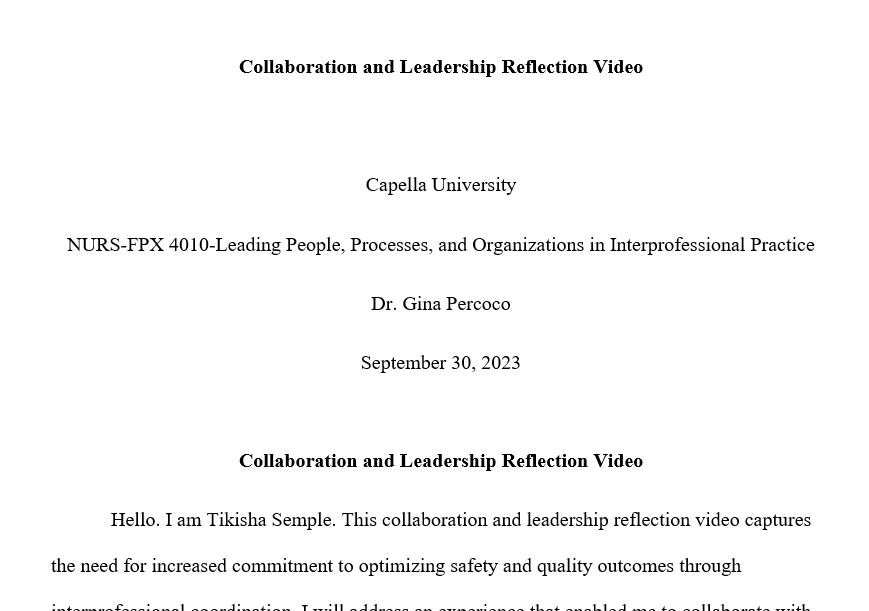NURS-FPX4010_S_Assessment 1-1 solution.docx
Collaboration and Leadership Reflection Video
Capella University
NURS-FPX 4010-Leading People, Processes, and Organizations in Interprofessional Practice
Dr. Gina Percoco
September 30, 2023
Collaboration and Leadership Reflection Video
Hello. I am Tikisha Semple. This collaboration and leadership reflection video captures the need for increased commitment to optimizing safety and quality outcomes through interprofessional coordination. I will address an experience that enabled me to collaborate with different healthcare professionals to meet a patient’s demands.
Notably, interdisciplinary collaboration reinforces commitment to improving quality and reducing cost of care by sharing ideas, skills, and experiences on effective care management (Hussain et al., 2018). The Vila Health scenario reinforces awareness about gaps and improvements necessary to produce the intended outcomes. The Healthix at Clarion Court Skilled Nursing Facility makes healthcare professionals aware of challenges in the clinical environment.
Events in the organization reflect the relevance of competent leadership in initiating team-based functions and encouraging shared aspirations across different departments (Tappen et al, 2017). In this sense, leaders encourage different healthcare professionals to embrace values, attitudes, and behaviors that make them responsive to patients’ demands regardless of their complications. Thus, the care team should acknowledge frontline roles that shape patients’ confidence and trust in the healthcare system.
Experience Being Part of an Interdisciplinary Team
I was part of a crisis response team during the COVID-19 pandemic. The health challenges triggered by the disease reinforced the need for well-coordinated initiatives to respond to patients’ demands. Working in a long-term care setting enabled me to collaborate with physicians, nurses, and clinical assistants for adequate response to elderly patients with multiple chronic conditions.
Majority of the patients had diabetes, Alzheimer’s disease, and high-blood pressure, which required careful attention to improve quality of life. A key success of the team was the willingness to embrace a shared goal to share insights into patients’ needs and the appropriate treatment pathway. Effective communication improved the quality of interprofessional collaboration (Rahman et al., 2017).
The process helps maintain seamless flow of information of patients’ medical history, medications, and improvements necessary to improve individuals’ quality of life. However, the complex nature of long-term care and delivering services at the peak of COVID-19 created challenges, including communication breakdowns, emotional and compassion fatigue, and anxiety. Nonetheless, the team remained committed to fulfilling frontline roles by sustaining patient confidence in the workforce’s ability to optimize care outcomes.
Collaborating with physicians, nurse colleagues, pharmacists, and clinical assistants provided an excellent opportunity to learn from their experiences. The lessons reinforced commitment to adopting team-based functions that help initiate and sustain effective interprofessional collaboration.
Another success of the collaborative initiative was shared decision-making, with leaders encouraging proactive contributions from everyone (Nilsen et al., 2020). As such, I was free to share ideas on the best ways of handling the elderly patients. For instance, I shared insights into support programs necessary to enhance optimism among patients.
Further, it was easier for the team to identify improvement areas such as responding to demands for culturally and linguistically appropriate services that match clients’ values and preferences. In the end, collective decision-making, respect, and professionalism enabled the team to remain resilient in addressing different health needs and expectations.
Strategies for Improving the Situation at Clarion Court
Clarion Court can make significant progress by addressing gaps and pursuing improvement opportunities available to optimize customer satisfaction. Clarion Court Skilled Nursing Facility’s efforts to adopt Healthix was a right move for an organization seeking to improving efficiency and effectiveness of patient care. One strategy for the organization is leadership changes to inspire a shared vision. The transformational and servant leadership styles are crucial to support the development of employees, provide a common goal, and vision (Rahman et al., 2017).
The aim is to develop a workforce that responds to organizational strategic priorities by listening, mentoring, empowering, and appreciating everyone’s contributions. In the end, it is easier for leaders to build a culture of collaboration and coordination when designing, testing, and implementing new processes, procedures, and systems.
Leaders should strive to embrace shared interdisciplinary governance to make informed decisions when introducing new methods. Stephen Silva expressed the need for horizontal communication where employees regardless of their positions discuss issues and make mutual conclusions. Nurses, physicians, pharmacists, the IT team, and non-clinical workers share ideas, knowledge, and experiences on handling new plans.
Secondly, effective communication allows leaders to clarify the purpose of a project (Nilsen et al., 2020). Clear chains of authority, emotional intelligence, and regulation are necessary to initiate informed conversations on changed intended to optimize care outcomes.
The existing upstream communication processes are ineffective since they limit employees from participating in decision-making. With improved communication, the leaders will break hierarchical barriers that limit the nursing and IT team from contributing ideas on successful implementation of a new system.
As I conclude, Clarion Court Skilled Nursing Facility ca restore employee confidence by redesigning the operating model to include interdisciplinary and shared governance. Streamlining communication frameworks is also crucial for leaders to embrace horizontal processes that help break barriers and encourage everyone to share insights into enablers of successful implementation of new systems.
Transformational and servant leadership also enhance collaboration to ensure that everyone understands the purpose and implications of the desired change.
References
Hussain, S. T., Lei, S., Akram, T., Haider, M. J., Hussain, S. H., & Ali, M. (2018). Kurt Lewin’s change model: A critical review of the role of leadership and employee involvement in organizational change. Journal of Innovation and Knowledge, 3(3), 123-127. https://www.sciencedirect.com/science/article/pii/S2444569X16300087
Nilsen, P., Seing, I., Ericsson, C., Birken, S., & Schildmeijer, K. (2020). Characteristics of successful changes in health care organizations: An interview study with physicians, registered nurses and assistant nurses. BMC Health Services Research, 20(147), 1-8. https://bmchealthservres.biomedcentral.com/articles/10.1186/s12913-020-4999-8
Rahman, W. A. (2017). Transformational leadership and empathy: The impact of quality in the health care services in Kelantan, Malaysia. International Journal of Economics, Business and Management Studies, 4(1), 50-56. https://ideas.repec.org/a/onl/ijebms/v4y2017i1p50-56id213.html
Tappen, R., Wold, D., Rahemi, Z., Engstrom, G., Rojido, C., Shutes, J., & Ouslander, J. (2017). Barriers and facilitators to implementing a change initiative in long-term care utilizing the INTERACT quality improvement program. The Health Care Manager, 36(3), 219-230. https://www.ncbi.nlm.nih.gov/pmc/articles/PMC5533173/pdf/nihms877516.pdf



